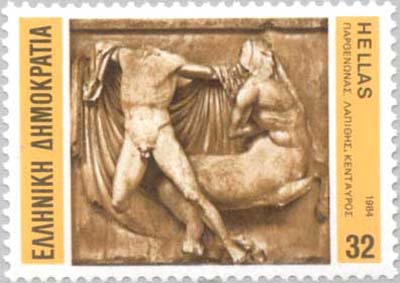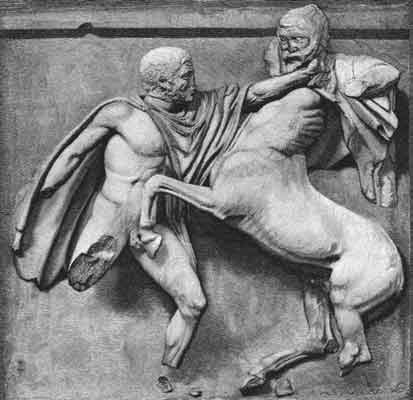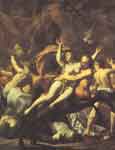
Lapith and Centaur, Parthenon
In Greek mythology, the Lapiths (Λαπίθαι) were a semi-legendary, semi-historical race, whose home was in Thessaly in the valley of the Peneus. Like the Myrmidons and other Thessalian tribes, the Lapiths were pre-Hellenic in their origins. The genealogies make them a kindred race with the Centaurs, their king Pirithous being the son, and the Centaurs the grandsons of Ixion. Perithous' mother was Dia, daughter of Eioneus, but like many heroic figures, Pirithous had an immortal as well as a mortal father. Zeus was his immortal father, but the god had to assume a stallion's form to cover Dia (Diodorus Siculus, iv.70) for, like their half-horse cousins, the Lapiths were horsemen in the grasslands of Thessaly, famous for its horses. The Lapiths were credited with inventing the bridle's bit. In fact, their king Pirithous was marrying the horsewoman Hippodameia, "tamer of horses", at the wedding feast a battle made famous. In the Iliad Pirithous sent forty manned ships, commanded by Polypoetes and Leontes.
The best-known legend with which the Lapiths are connected is their battle with the Centaurs at the wedding feast of Pirithous. The Centaurs had been invited, but, unused to wine, their wild nature came to the fore. When the bride was presented to greet the guests, the centaur Eurytion leapt up and attempted to rape her. All the other centaurs were up in a moment, straddling women and boys. In the battle that ensued, Theseus came to the Lapiths' aid. They cut off Eurytion's ears and nose and threw him out. In the battle the Lapith Cæneus was killed, and the defeated Lapiths were expelled from Thessaly to the northwest.
Caeneus was a well-known Lapith, originally a girl named Cænis and the favourite of Poseidon, who changed her into a man at her request and made her an invulnerable warrior. Such warrior women, indistinguishable from men, were familiar among the Scythian horsemen too (see the entry "Amazons") and survive among Albanian traditions. In the Centaur battle, Caeneus proved invulnerable, until the Centaurs simply crushed him with rocks and trunks of trees, he disappeared into the depths of the earth unharmed and was released as a sandy-headed bird.
In later contests the Centaurs were not so easily beaten. Mythic references explained the presence into historic times of primitive Lapiths in Malea and in the brigand stronghold of Pholoe in Elis as remnants of groups driven there by the Centaurs. Some historic Greek cities bore names connected with Lapiths, and the Kypselides of Corinth claimed descent from Cæneus, while the Phylaides of Attica claimed for progenitor Koronus the Lapith [1] (http://www.hostkingdom.net/gktrib.html).
As Greek myth became more mediated through philosophy, the battle between Lapiths and Centaurs took on aspects of the interior struggle between civilized and wild behavior, made concrete in the Lapiths' understanding of the right usage of god-given wine, which must be tempered with water and drunk not to excess. The Greek sculptors of the school of Pheidias conceived of the battle of the Lapithae and Centaurs as a struggle between mankind and mischievous monsters, and symbolical of the great conflict between the civilized Greeks and n "barbarians". Battles between Lapiths and Centaurs were depicted in the sculptured friezes on the Parthenon, recalling Athenian Theseus' treaty of mutual admiration with Pirithous the Lapith, leader of the Magnetes, and on Zeus' temple at Olympia (Pausanias, v.10.2). The Battle of the Lapiths and Centaurs was a familiar symposium theme for the vase-painters [2] (http://members.aol.com/JWFvase2/page/cataloga1.htm#Florence%204029).
A sonnet vividly evoking the battle by the French poet José-Maria de Heredia (1842 – 1905) was included in his volume Les Trophées [3] (http://poesie.webnet.fr/poemes/France/heredia/12.html).
Ovid Metamorphoses XII passim; Odyssey XXI, 330 – 340.

Lapith und Centaur, Metope (south 7), c. 440 BC , Parthenon , British Museum

Zeus Temple, Lapith Woman
Links
- Hellenic tribes (http://www.hostkingdom.net/gktrib.html)
- Calos Parada, "Lapiths" (http://homepage.mac.com/cparada/GML/LAPITHS.html): an annotated list of Lapith names, mainly in Metamorphoses, and some Lapith descendents
- The Battle painted on Greek vases (http://members.aol.com/JWFvase2/page/lapiths.html)
- In the Renaissance, the battle became a favorite theme for artists : an excuse to display close-packed bodies in violent confrontation. The young Michelangelo executed a marble bas-relief of the subject in Florence about 1492 [4] (http://www.artrenewal.org/asp/database/image.asp?id=1565). Piero di Cosimo's panel now at the National Gallery, London ( NG4890 (http://www.nationalgallery.org.uk/cgi-bin/WebObjects.dll/CollectionPublisher.woa/wa/work?workNumber=NG4890)) painted during the following decade, if it was originally part of a marriage chest, or cassone, was perhaps an uneasy subject for a festive wedding commemoration.
See also : Greek Mythology. Paintings, Drawings
Retrieved from "http://en.wikipedia.org/"
All text is available under the terms of the GNU Free Documentation License
| Ancient Greece
Science, Technology , Medicine , Warfare, , Biographies , Life , Cities/Places/Maps , Arts , Literature , Philosophy ,Olympics, Mythology , History , Images Medieval Greece / Byzantine Empire Science, Technology, Arts, , Warfare , Literature, Biographies, Icons, History Modern Greece Cities, Islands, Regions, Fauna/Flora ,Biographies , History , Warfare, Science/Technology, Literature, Music , Arts , Film/Actors , Sport , Fashion --- |





